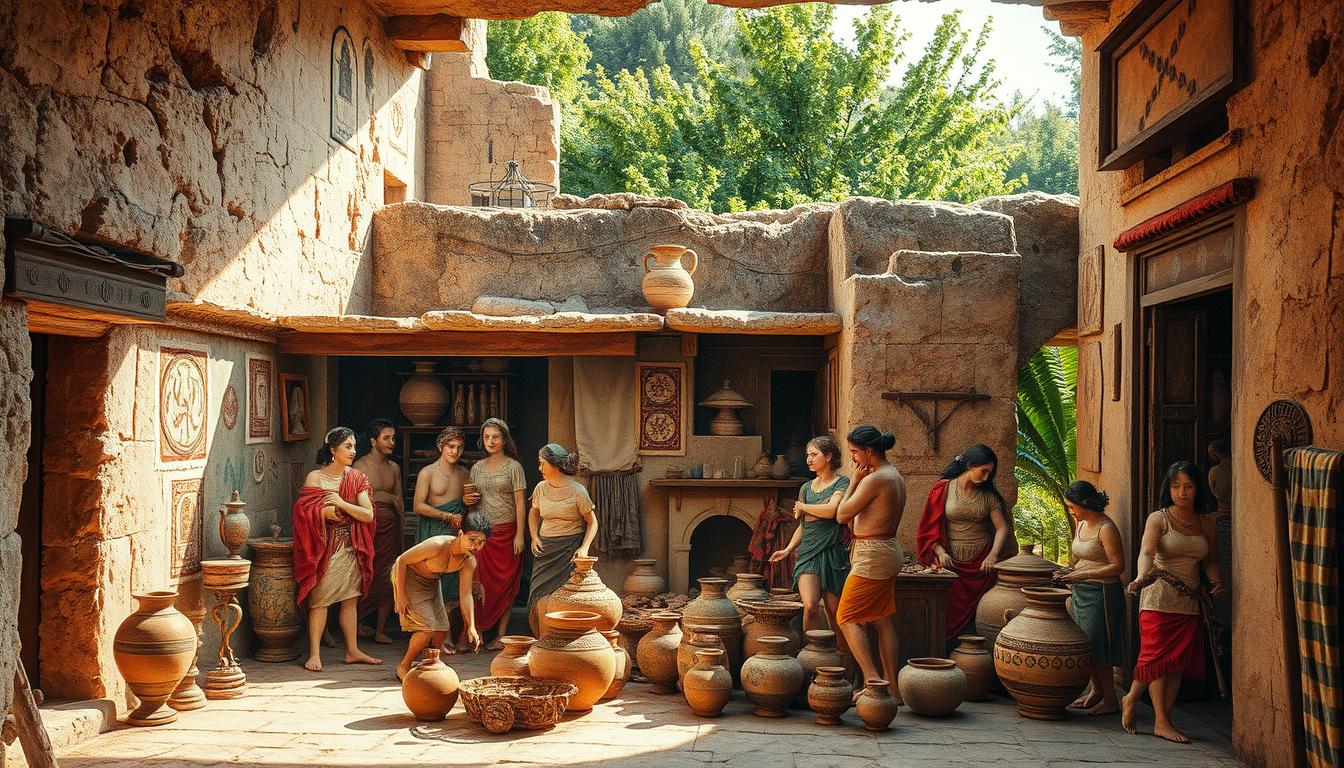
The Timeless Beauty of ancient artz
ancient artz offers a fascinating glimpse into the creativity and lives of civilizations long gone. Its importance extends beyond aesthetic value—it reflects the philosophies, spiritual beliefs, and socio-political environments of the time. By exploring ancient artz, we unravel the threads of history, culture, and human emotion. Let’s embark on a journey through the remarkable world of ancient art.
Understanding ancient artz: A Window into History
ancient artz is the artistic expression created by early civilizations, spanning from prehistoric times to the fall of the Roman Empire in the 5th century AD. It serves as an essential record of humanity’s earliest endeavors in communicating ideas, emotions, and cultural narratives. Through art, ancient societies documented their belief systems, struggles, victories, and technological advancements.
The mediums and techniques of ancient art were diverse, ranging from cave paintings and pottery to monumental sculptures and intricate jewelry. The materials used, such as clay, stone, metals, and pigments derived from natural sources, illustrate how these early artists harnessed their environment to create enduring works.
Cave Paintings: The Dawn of Human Expression
Among the earliest forms of ancient artz, cave paintings offer profound insights into the lives of prehistoric people. Found in caves like those at Lascaux in France and Altamira in Spain, these paintings date back to around 40,000 years ago. They depict animals, hunting scenes, and abstract symbols, suggesting an early attempt to communicate through visual storytelling.
The vivid representations of bison, deer, and horses on cave walls provide evidence of a deep connection between early humans and their environment. These artworks were not mere decorations but served ritualistic and spiritual purposes, possibly linked to hunting magic or shamanistic practices.
The Art of Mesopotamia: The Cradle of Civilization
As one of the earliest cradles of civilization, Mesopotamia (modern-day Iraq) gave rise to some of the most influential forms of ancient artz. The Sumerians, Babylonians, and Assyrians produced intricate sculptures, elaborate bas-reliefs, and grand architectural structures.
One of the most iconic examples is the Ziggurat of Ur, a massive temple complex that symbolized the connection between heaven and earth. The famous stele of Hammurabi, inscribed with one of the world’s oldest legal codes, showcases the importance of art in governance and law.
Mesopotamian art was characterized by its attention to detail and narrative focus, often depicting gods, kings, and battles. These works of art were not only meant to glorify rulers but also to communicate divine will and social order.
Egyptian ancient artz: The Eternal Quest for Immortality
Egyptian art is perhaps one of the most recognizable and enduring forms of ancient expression. Dominated by themes of death and the afterlife, Egyptian art was deeply intertwined with the religious beliefs of this ancient civilization.
From the majestic pyramids of Giza to the intricate hieroglyphics adorning tombs, Egyptian art sought to ensure the eternal life of the soul. Pharaohs, believed to be gods on earth, were immortalized in grand statues and tomb paintings.
The rigid, highly stylized figures in Egyptian art reflect the society’s emphasis on order and continuity. Symbols such as the ankh (representing life) and the eye of Horus (symbolizing protection) were prominent features in Egyptian art, both in monumental sculptures and everyday objects.
The Artistic Legacy of Ancient Greece: Idealism and Humanism
Greek art marked a revolutionary departure from the rigid conventions of earlier civilizations. Known for its emphasis on realism, proportion, and the human form, ancient Greek art laid the foundation for Western artistic traditions.
Sculptures from the Classical period, such as the iconic “Discobolus” (Discus Thrower) by Myron and the “Venus de Milo,” exemplify the Greeks’ fascination with idealized human beauty. The Greeks pioneered the use of contrapposto—a stance where the weight of the body is shifted to one leg—giving their statues a more dynamic and lifelike quality.
Greek art wasn’t confined to sculpture alone. Pottery, often adorned with scenes from mythology, daily life, and athletic contests, provided a narrative window into the values and customs of ancient Greece. The Parthenon in Athens, with its intricate friezes and Doric columns, remains a testament to the architectural genius of the Greeks.
Roman Art: Power, Propaganda, and Public Works
Heavily influenced by Greek traditions, Roman art expanded upon them to suit its own needs—often using art as a tool of propaganda. The Romans were masters of portraiture, capturing not only the physical likeness of their subjects but also their character and status.
Statues of emperors like Augustus and Trajan were erected throughout the empire, projecting an image of power and divine favor. Roman mosaics, adorning floors and walls, depicted everything from mythological scenes to everyday life, showcasing the wealth and sophistication of the Roman elite.
One of the most significant contributions of Roman art was in architecture. The Colosseum, the Pantheon, and triumphal arches like that of Constantine, combined functionality with grandeur, illustrating Rome’s engineering prowess and its ability to impress and control its vast empire.
Art of the Indus Valley: A Mysterious Civilization
The Indus Valley Civilization, which flourished around 2500 BCE in what is now Pakistan and northwest India, produced art that remains enigmatic due to the undeciphered script of its people. Yet, the terracotta figurines, seals, and pottery they left behind offer clues to their advanced urban culture.
One of the most famous artifacts from this civilization is the “Dancing Girl” statue, a bronze figure that captures the grace and poise of its subject. Seals, often depicting animals and mythological creatures, suggest a deep connection to nature and perhaps a form of early religious or ritualistic practice.
Unlike the monumental structures of Egypt or Mesopotamia, the art of the Indus Valley is more intimate, focusing on smaller, everyday objects. This suggests a society where art was woven into daily life, used for both functional and decorative purposes.
Chinese Art: Philosophical Depth and Symbolism
Ancient Chinese art, particularly from the Shang and Zhou dynasties, is renowned for its rich symbolism and connection to Confucianism, Daoism, and Buddhism. From jade carvings to intricate bronze vessels, Chinese art reflects a profound respect for nature, the cosmos, and the ancestors.
The terracotta army of the First Emperor, Qin Shi Huang, is one of the most extraordinary archaeological finds of the 20th century. This massive collection of life-sized clay soldiers, horses, and chariots, created to accompany the emperor into the afterlife, underscores the importance of immortality in Chinese culture.
In addition to sculpture, Chinese calligraphy and landscape painting became highly esteemed art forms. The fluid brushstrokes of calligraphy were seen as an expression of the artist’s inner spirit, while landscapes captured the harmonious relationship between humans and nature.
ancient artz of the Americas: From Olmecs to the Maya
The ancient civilizations of the Americas, including the Olmecs, Maya, and Aztecs, produced stunning works of art that rivaled those of their counterparts across the ocean. The Olmec colossal heads, carved from basalt, represent some of the earliest examples of monumental sculpture in the Americas.
Maya art, known for its detailed stelae and intricate ceramics, often depicted kings, gods, and ritual scenes. The Maya developed a sophisticated writing system and used art to record historical events, religious ceremonies, and cosmological beliefs.
Aztec art, often created with religious intent, was characterized by a mix of realism and stylization. From intricately carved stone temples to elaborate featherwork and gold jewelry, Aztec art reflected the grandeur and power of their empire.
Faq’s
How did ancient artz influence modern art?
ancient artz laid the foundations for many artistic techniques and principles still used today, such as perspective, realism, and symbolism. Modern artists often draw inspiration from ancient art forms, blending them with contemporary styles to create new artistic expressions.
Why was art important in ancient civilizations?
Art played a crucial role in ancient civilizations by documenting history, conveying religious beliefs, and expressing societal values. It was also used to honor rulers and deities, preserve cultural heritage, and communicate across generations.
What materials did ancient artists use?
Ancient artists used a variety of materials, including clay, stone, metal, wood, and pigments from natural sources. The choice of material often depended on the region’s resources and the artwork’s intended purpose.
What is the oldest known form of ancient art?
Cave paintings, such as those found in Chauvet Cave in France, are considered the oldest known forms of ancient art, dating back over 30,000 years. These early works depict animals and abstract symbols, offering insights into prehistoric life.
How did ancient art evolve over time?
Ancient art evolved as societies grew more complex and technological advancements allowed for new artistic techniques. Early art focused on survival and spirituality, while later civilizations explored more sophisticated themes, such as politics, humanism, and idealism.
What are some of the most famous ancient artworks?
Some of the most famous ancient artworks include the Great Pyramids of Giza, the Parthenon in Greece, the Terracotta Army in China, and the sculptures of Augustus in Rome. These works have

